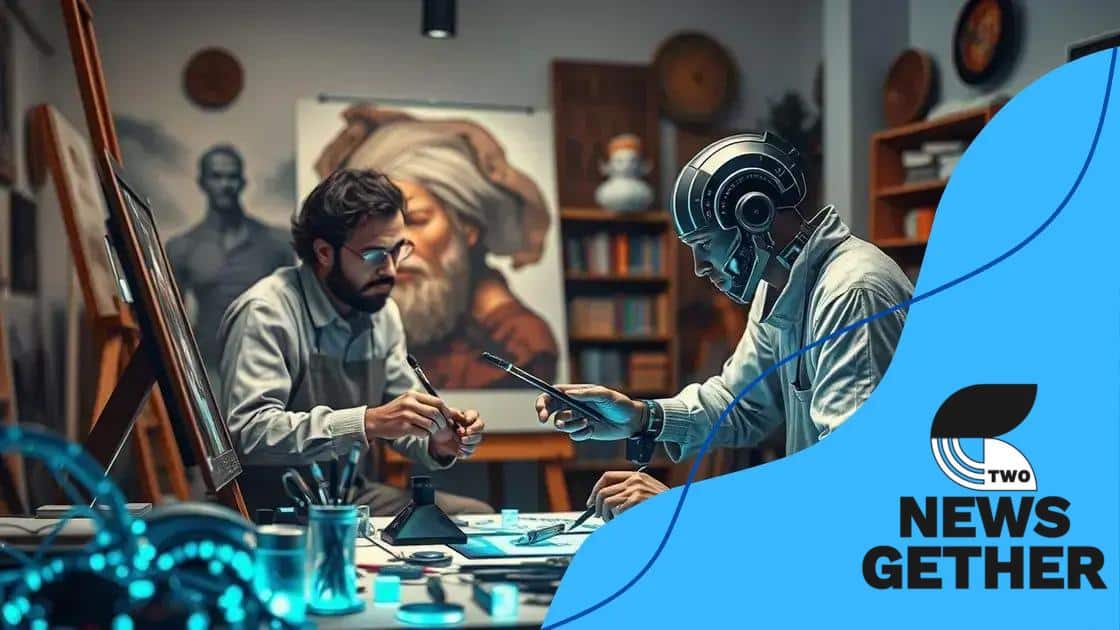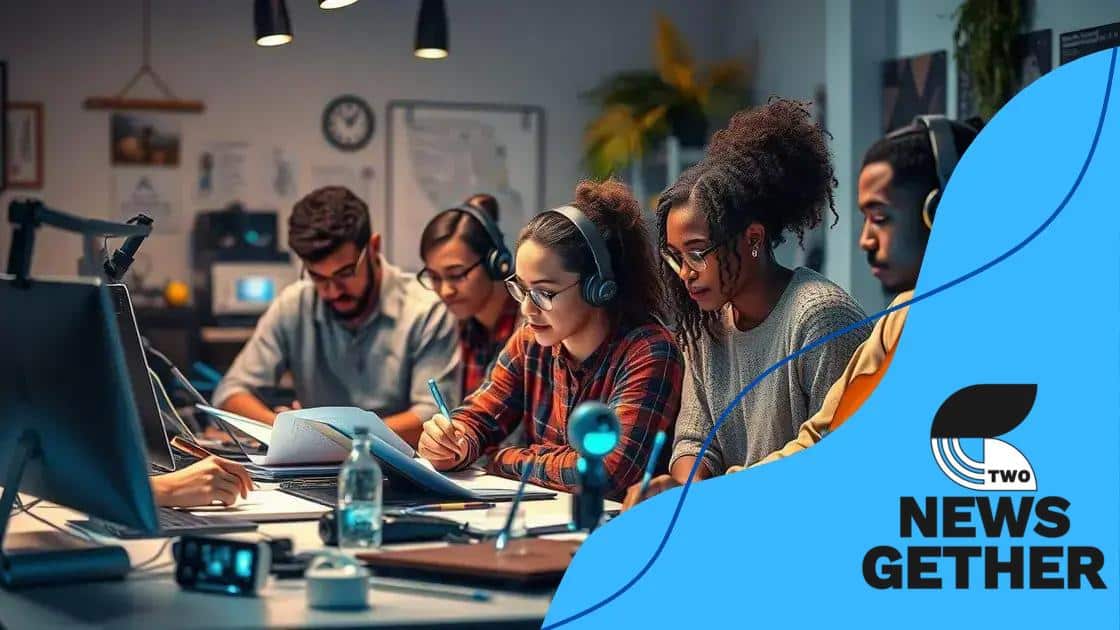The role of AI in transforming the creative industries

The role of AI in transforming the creative industries involves enhancing collaboration, personalizing content, and driving innovation, while also presenting challenges like quality concerns and ethical issues.
The role of AI in transforming the creative industries is more significant than ever. Imagine a world where art and technology collide, leading to groundbreaking creations and new forms of expression. How is AI changing the landscape of the arts today?
How AI is reshaping artistic expression
AI is fundamentally changing how artists create and share their work. With tools powered by artificial intelligence, artists can explore new avenues of expression that were previously unimaginable.
One of the exciting aspects of AI in the arts is how it enables collaboration. Artists can use AI to generate ideas or even create entire pieces. This opens up a dialogue between human creativity and machine learning, enriching the creative process.
Creative tools enhanced by AI
Today, many artists utilize AI-powered platforms that assist in various artistic endeavors, including:
- Music creation: AI can compose music or suggest melodies that artists might not have considered.
- Visual art: Programs can analyze styles and help artists develop unique blends of techniques.
- Writing assistance: AI can help generate story ideas, improve prose, or suggest plot developments.
Moreover, AI can analyze trends and audience preferences, helping artists tailor their work to fit what viewers want. This data-driven approach gives creators insight into the emotional impact of color or melody, enhancing their ability to evoke feelings in their audience.
AI’s role in traditional and digital art
The integration of AI is not limited to digital realms. Traditional artists are now incorporating AI-generated elements into their works, creating a fusion of traditional artistry and modern technology. This blend fosters innovation and challenges the definition of what art is.
For instance, many artists are printing AI-generated patterns and designs as part of their physical art pieces. This transformation allows for a new dialogue about creativity, suggesting that artistic expression can stem from both human and artificial intelligence.
In conclusion, the role of AI in reshaping artistic expression presents endless possibilities. Artists can harness this technology to enhance their creativity, pushing the boundaries of what can be imagined and created.
The impact of AI on content creation
The impact of AI on content creation is profound and transformative. As technology evolves, creators are discovering innovative ways to enhance their work using artificial intelligence.
AI tools are now widely available, making it easier for writers, designers, and video producers to improve their craft. These tools can analyze trends, suggest edits, and even generate ideas. Incorporating AI into content creation empowers creators to focus more on their creative vision.
How AI streamlines the writing process
When it comes to writing, AI can assist writers in numerous ways. For example,
- Grammar and style checks: AI tools can identify mistakes and suggest improvements, helping writers polish their work.
- Content generation: Some platforms allow users to input prompts, generating paragraphs of text that can be used or edited.
- Research assistance: AI can quickly gather relevant information, saving writers valuable time during the research phase.
These advancements make the writing process faster and more efficient. Writers can spend less time on mundane tasks and more time developing themes and voices in their work.
Visual content creation enhanced by AI
It’s not just writing that benefits from AI; visual content creation has also seen major improvements. Designers are using AI to create stunning graphics and layouts that capture attention. AI tools can facilitate these processes by:
- Generating design ideas: AI can produce numerous design options based on user input.
- Image editing: Advanced AI software streamlines the process of enhancing photos.
- Automating repetitive tasks: This allows designers to focus on the more creative aspects of their projects.
As a result, the quality of visual content has improved significantly, and the creative possibilities are almost limitless. AI enables creators to push the boundaries of their imagination while ensuring a high standard of quality in their work.
Overall, the intersection of AI and content creation opens up exciting opportunities for creators across the board. As technology continues to advance, we can expect even more innovative tools and methods that enhance the creative process.
AI tools for enhancing creativity

AI tools for enhancing creativity are revolutionizing how artists and creators approach their work. These innovative technologies offer new ways to explore ideas and execute projects more efficiently.
By leveraging artificial intelligence, creators can tap into a wealth of resources that inspire originality and improve productivity. Many AI platforms are designed specifically to aid in various creative tasks, from writing to design and beyond.
Types of AI tools available
There are several categories of AI tools that can support creativity, including:
- Writing assistants: These tools can help generate ideas, provide grammar checks, and enhance overall writing quality.
- Design software: AI-powered design platforms can suggest layouts, color palettes, and even create unique graphics.
- Music composition tools: AI applications can compose music or offer recommendations based on the user’s style.
- Video editing software: AI can streamline the editing process by automating tasks like transitions, effects, and even video content generation.
These tools not only make the creative process quicker but also offer fresh perspectives that challenge traditional methods. As creators use these AI resources, they often find innovative solutions and ideas that push their work beyond previous boundaries.
Benefits of using AI in creative processes
Using AI can provide numerous benefits, such as increased efficiency and expanded creative possibilities. For example, artists can quickly iterate on designs and receive real-time feedback, allowing them to refine their concepts faster than ever. This immediate response nurtures the creative flow, enabling creators to focus more on their vision.
Moreover, AI can help mitigate creative blocks. When an artist feels stuck, an AI tool can suggest new directions, prompts, or styles that spark inspiration. The collaborative nature of working with AI allows creators to experiment and innovate freely.
Ultimately, integrating AI tools into the creative process can enhance the quality of work while saving time. As technology continues to evolve, the potential for creativity powered by AI will only grow.
Challenges in AI-driven creative processes
Challenges in AI-driven creative processes are becoming more apparent as technology evolves. While AI offers amazing opportunities, it also poses unique obstacles for creators in various fields.
One major concern is the dependence on AI tools. As artists and writers integrate artificial intelligence into their workflows, they may become reliant on these technologies. This dependence can lead to a decrease in originality and creative thinking. Instead of pushing boundaries, some creators might find themselves following suggestions made by AI.
Quality and authenticity concerns
Another challenge lies in the quality of content produced by AI. While these tools can generate impressive work, there is the risk that they may lack the emotional depth and authenticity that human creators provide. For example:
- Lack of human touch: AI-generated art and writing can sometimes feel soulless, missing the personal experiences that shape true creativity.
- Generic outputs: Some AI tools may produce similar content for different users, leading to a loss of unique identity in creative works.
- Misinterpretation: AI can misinterpret prompts or context, resulting in content that doesn’t resonate with audiences.
These concerns highlight the need for a balanced approach when integrating AI into the creative process. Creators must consider how much they rely on technology versus their own creativity and intuition.
Ethical considerations
There are also ethical challenges in using AI tools. Issues like copyright and ownership come into play. For instance, if an AI generates a piece of art, who truly owns that work? Is it the developer of the AI, the user, or does it belong to the AI itself? This ambiguity can lead to disputes and confusion within the creative community.
Additionally, the use of AI can raise questions about fairness and representation. If a creator uses an AI trained on biased data, the outputs may reflect those biases, perpetuating stereotypes or excluding certain voices.
Overall, while AI presents exciting possibilities for creativity, it is essential to address these challenges to create a sustainable, ethical, and authentic creative landscape.
Future trends in AI and creative industries
Future trends in AI and creative industries are shaping the landscape of creativity today and will continue to do so in the years to come. As technology evolves, artists and creators are beginning to embrace artificial intelligence in innovative ways.
One major trend is the growing collaboration between humans and AI. More creators are using AI tools as co-creators instead of replacements. This partnership can lead to fascinating new art forms, blending human emotion with algorithmic precision.
Personalized content creation
Another trend involves the personalization of content. AI is getting better at analyzing user preferences and behaviors. This allows creators to tailor their work to specific audiences. By doing so, artists can build deeper connections with their viewers. For example:
- Customized music playlists: AI can suggest songs based on individual listening habits.
- Personalized reading experiences: Readers may find stories that cater to their interests through AI recommendations.
- Interactive and immersive experiences: AI can create tailor-made visual art or AR experiences.
This focus on personalization makes content more engaging and relevant, leading to a richer experience for audiences.
AI in emerging art forms
Emerging art forms like virtual reality (VR) and augmented reality (AR) are also on the rise, thanks largely to AI advancements. Artists are exploring new realms of creativity that blend the physical and digital worlds. For instance, through the use of VR, creators can construct entire environments where viewers can immerse themselves in their art.
Additionally, AI-generated content will become more commonplace in the creative industries. From graphic design to music composition, AI tools will assist in creating new, unique works. This trend raises questions about authorship and originality, sparking further discussions in the art community.
As AI continues to evolve, it will drive the creative process forward, encouraging artists to embrace technology and explore innovative ways of storytelling. The future of creativity lies in the collaboration between humans and machines, paving the way for a new era of artistic expression.
In conclusion, the intersection of AI and the creative industries opens up exciting possibilities. While there are challenges to navigate, the future is bright with innovation and collaboration. Artists have the opportunity to enhance their creativity and reach new audiences through the use of AI tools. By balancing technology with the human touch, the creative landscape will continue to evolve and inspire. As we move forward, embracing AI in creative processes can lead to unique expressions and transformative experiences in art and media.
FAQ – Frequently Asked Questions about AI in Creative Industries
How does AI enhance the creative process?
AI tools assist artists by generating ideas, improving efficiency, and providing new perspectives, allowing for greater creativity.
What are some examples of AI tools used in creativity?
Examples include design software that generates graphics, writing assistants that suggest edits, and music composition tools that create melodies.
What challenges do creators face when using AI?
Challenges include potential over-reliance on technology, quality issues in AI-generated content, and ethical concerns regarding authorship.
How can AI personalize content for audiences?
AI analyzes user preferences and behaviors, allowing creators to tailor their work and engage audiences more effectively.






